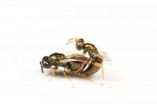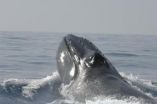(Press-News.org) TEMPE, Ariz. – You may want to ramp up your romance this year by sharing a candlelight dinner, a walk on the beach, or even the scent of a perfume, but will that help you find your perfect mate? For one wasp species, it only takes a whiff of his special love potion to know whether he's "Mr. Right."
Unlike humans, most insects rely on their sense of smell when looking for a mate. Scientists have found that sex pheromones play an important role in finding a suitable partner of the same species; yet, little is known about the evolution and genetic basis of these alluring smells.
A team of researchers from Arizona State University and Germany found that one wasp species has evolved a specific scent, or pheromone, which keeps it from mating with other species. In addition, they discovered that the genetic basis of the new scent is simple, which allows the males to change an existing scent into a new one. Over time, the females recognize and use this new scent to distinguish their own species from others.
Scientists from ASU, the University of Regensburg, the Zoological Research Museum Alexander Koenig Bonn, and the Technical University Darmstadt in Germany, present their findings in an article published Feb. 13 online in the journal Nature.
The researchers studied two species of the parasitic wasp genus Nasonia to learn about the evolution of sex pheromones. They asked, if male sex pheromones are used as unique mating signals to attract females, and if female wasps will not mate with males that have different pheromones, then how did the vast array of these scents evolve in insects?
They found that the pheromones of all known Nasonia wasps contain two elements except for one species, Nasonia vitripennis, which uses a novel third ingredient. These tiny wasps, less than half the size of a grain of rice, lay their eggs in developing flies. The two species in this study prefer laying their eggs in similar types of flies and are found in the same parts of the Eastern United States, which means they have many opportunities to choose the wrong mate.
"We identified a gene in N. vitripennis that we thought was responsible for its unique scent," said Josh Gibson, an ASU doctoral student working with Jürgen Gadau, a professor in School of Life Sciences in the College of Liberal Arts and Sciences. "Then, we successfully conducted an experiment to suppress that gene, which actually changed the composition of the sex pheromone, so that it resembled that of the other species," Gibson added.
Female N. vitripennis wasps did not respond when offered the new pheromone alone. They responded only when it was combined with the two original, or ancestral, scents. In addition, females from a closely related species, Nasonia giraulti, did not distinguish between the new and ancestral sex pheromones, regardless of whether there were two or three scents.
Thus, the researchers concluded that the N. vitripennis females did not react to the third component when it first evolved. Instead, they adapted to the new smell over time and now it is an integral part of the species-specific sex pheromone of N. vitripennis males.
This study is one of the few where researchers have identified genes that prevent a species from breeding with another closely related species. The findings provide new insights into the evolution of genes that contribute to speciation, or the formation of new species, as well as the evolution of diverse sex pheromones.
"The females use this smell to distinguish between the species," said Gibson. "This is important. If an individual wasp were to mate with a different species, it would be very costly because they would not produce viable offspring. We learned that the smell difference is based on a single and simple chemical change. Basically, this is the way the female wasp can find Mr. Right."
INFORMATION:
Finding 'Mr. Right,' how insects sniff out the perfect mate
Researchers discover how sex pheromones evolved in wasps
2013-02-14
ELSE PRESS RELEASES FROM THIS DATE:
Scientists discover how animals taste, and avoid, high salt concentrations
2013-02-14
New York, NY (February 13, 2013) —For consumers of the typical Western diet—laden with levels of salt detrimental to long-term health—it may be hard to believe that there is such a thing as an innate aversion to very high concentrations of salt.
But Charles Zuker, PhD, and colleagues at Columbia University Medical Center have discovered how the tongue detects high concentrations of salt (think seawater levels, not potato chips), the first step in a salt-avoiding behavior common to most mammals.
The findings could serve as a springboard for the development of taste ...
A war without end -- with Earth's carbon cycle held in the balance
2013-02-14
CORVALLIS, Ore. – The greatest battle in Earth's history has been going on for hundreds of millions of years, isn't over yet, and until now no one knew it existed, scientists reported today in the journal Nature.
In one corner is SAR11, a bacterium that's the most abundant organism in the oceans, survives where most other cells would die and plays a major role in the planet's carbon cycle. It had been theorized that SAR11 was so small and widespread that it must be invulnerable to attack.
In the other corner, and so strange looking that scientists previously didn't ...
Penn geologists quantify, characterize sediment carried by Mississippi flood to Louisiana's wetlands
2013-02-14
PHILADELPHIA — The spring 2011 flood on the Mississippi was among the largest floods ever, the river swelling over its banks and wreaking destruction in the surrounding areas. But a University of Pennsylvania-led study also shows that the flood reaped environmental benefits — transporting and laying down new sediment in portions of the Delta — that may help maintain the area's wetlands.
The study, led by Ph.D. student Nicole Khan of the Department of Earth and Environmental Science, is the first to quantify the amount of sediment transported to wetlands by a flood on ...
Happily married couples consider themselves healthier, expert says
2013-02-14
COLUMBIA, Mo. – Research shows that married people have better mental and physical health than their unmarried peers and are less likely to develop chronic conditions than their widowed or divorced counterparts. A University of Missouri expert says that people who have happy marriages are more likely to rate their health as better as they age; aging adults whose physical health is declining could especially benefit from improving their marriages.
Christine Proulx, an assistant professor in the MU Department of Human Development and Family Studies, examined the long-term ...
Facial structure may predict endorsement of racial prejudice
2013-02-14
The structure of a man's face may indicate his tendency to express racially prejudiced beliefs, according to new research published in Psychological Science, a journal of the Association for Psychological Science.
Studies have shown that facial width-to-height ratio (fWHR) is associated with testosterone-related behaviors, which some researchers have linked with aggression. But psychological scientist Eric Hehman of Dartmouth College and colleagues at the University of Delaware speculated that these behaviors may have more to do with social dominance than outright aggression.
The ...
NASA scientists part of Arctic Sea ice study
2013-02-14
New research using combined records of ice measurements from NASA's Ice, Cloud and Land Elevation Satellite (ICESat), the European Space Agency's CryoSat-2 satellite, airborne surveys and ocean-based sensors shows Arctic sea ice volume declined 36 percent in the autumn and 9 percent in the winter over the last decade. The work builds on previous studies using submarine and NASA satellite data and confirms computer model estimates that showed ice volume decreases over the last decade, and builds a foundation for a multi-decadal record of sea ice volume changes.
In a report ...
Resignation of Pope Benedict XVI demands a close look at rules of modern papal election
2013-02-14
New Rochelle, NY, February 13, 2013—When Pope Benedict XVI ends his reign at the end of February he will be the first pope to do so before his death in nearly 600 years. He shocked the Catholic Church by announcing his resignation and set in place a centuries-old process to select his successor. The fascinating Conclaves system for electing a new pope, which has been in place since the late 1200s is described in "Creating the Rules of the Modern Papal Election," published in Election Law Journal, from Mary Ann Liebert, Inc., publishers. The article is available on the Election ...
Why there are bad learners: EEG activity predicts learning success
2013-02-14
The reason why some people are worse at learning than others has been revealed by a research team from Berlin, Bochum, and Leipzig, operating within the framework of the Germany-wide network "Bernstein Focus State Dependencies of Learning". They have discovered that the main problem is not that learning processes are inefficient per se, but that the brain insufficiently processes the information to be learned. The scientists trained the subjects' sense of touch to be more sensitive. In subjects who responded well to the training, the EEG revealed characteristic changes ...
Genetic study pursues elusive goal: How many humpbacks existed before whaling?
2013-02-14
Scientists from Stanford University, the Wildlife Conservation Society, the American Museum of Natural History, and other organizations are closing in on the answer to an important conservation question: how many humpback whales once existed in the North Atlantic?
Building on previous genetic analyses to estimate the pre-whaling population of North Atlantic humpback whales, the research team has found that humpbacks used to exist in numbers of more than 100,000 individuals. The new, more accurate estimate is lower than previously calculated but still two to three times ...
Robots with lift
2013-02-14
They can already stand, walk, wriggle under obstacles, and change colors. Now researchers are adding a new skill to the soft robot arsenal: jumping.
Using small explosions produced by a mix of methane and oxygen, researchers at Harvard have designed a soft robot that can leap as much as a foot in the air. That ability to jump could one day prove critical in allowing the robots to avoid obstacles during search and rescue operations. The research is described in a Feb. 6 paper in the international edition of Angewandte Chemie.
"Initially, our soft robot systems used pneumatic ...
LAST 30 PRESS RELEASES:
Drone sampling of whale breath reveals first evidence of potentially deadly virus in Arctic
Roman soldiers defending Hadrian’s Wall infected by parasites, study finds
Pinochet’s prisoners were tormented with music but still found solace in it, a new book reveals
Fertility remains high in rural Tanzania despite access to family planning
AI-assisted device can improve autism care access
Kinetic careers
Uncovering how parasitic plants avoid attacking themselves to improve crop resistance
Nanoparticle vaccine strategy could protect against Ebola and other deadly filoviruses
Study finds brain care score can predict risk of stroke across racial groups
Key lung immune cells can intensify allergic reactions
Do hormones explain why women experience more gut pain?
New materials conduct ions in solids as easily as in liquids
Breakthrough of the Year: Renewable energy begins to eclipse fossil fuel-based sources
LLM use is reshaping scientific enterprise by increasing output, reducing quality and more
Introducing LightGen, a chip for ultra-fast, ultra-efficient generative AI
Astronomers see fireworks from violent collisions around nearby star
ACC/AHA issue new guideline on managing congenital heart disease in adults
Cosmic crash caught on camera
Is talented youth nurtured the wrong way? New study shows: top performers develop differently than assumed
Ants: An untapped resource in the development of antibiotics?
Archaeologists use AI to create prehistoric video game
Mitochondria migrate toward the cell membrane in response to high glucose levels
Tiny viral switch offers hope against drug-resistant bacteria
Most parents aware of early peanut introduction guidelines, but confused about details
HPV vaccine can protect against severe lesions of the vulva and vagina
Virtual care provision and emergency department use among children and youth
Quadrivalent HPV vaccine and high-grade vulvovaginal lesions
Insights into dry eyes gained from stem cell-derived tear glands
Researchers identify 166 human pluripotent stem cell lines available for use in clinical applications
Europa Clipper instrument uniquely observed interstellar comet 3I/ATLAS
[Press-News.org] Finding 'Mr. Right,' how insects sniff out the perfect mateResearchers discover how sex pheromones evolved in wasps



